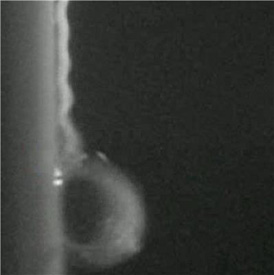Apr 12 2011
When a drop falls on a lotus flower it remains on the surface without wetting it. This is due, firstly, to the chemical components of the leaves of this plant, which are hydrophobic and therefore repel water, and, secondly, to the nanostructure of the surface, which augments the repellent effect.
Taking these nanostructural properties as a starting point, researchers from the Faculty of Physics at the University of Barcelona have carried out a study - the results of which have been published in the journal Nature Materials - in which they demonstrate the physical conditions required for the controlled production of drops between the micro- and nanoscales.
 In the experiments carried out for the study, focusing on water in air, the team of researchers has demonstrated the operation of the microfluidic model and created drops at the micrometre scale, but the model is also capable of producing nanometric droplets.
In the experiments carried out for the study, focusing on water in air, the team of researchers has demonstrated the operation of the microfluidic model and created drops at the micrometre scale, but the model is also capable of producing nanometric droplets.
The study details the different physical conditions needed to destabilize a fluid and create droplets according to the wetting properties of the surface it is in contact with. Ignasi Pagonabarraga, a lecturer with the Department of Fundamental Physics and one of the authors of the study, explains that "the interaction of the fluid with the surface can be used to control the size of the drops and the time they take to form. Although there are other methods for creating micrometric droplets, the affinity of liquids to solid surfaces creates a more versatile environment for the production and control of drops down to the nanoscale".
According to Aurora Hernández-Machado, a lecturer with the UB's Department of Structure and Constituents of Matter and co-author of the study, "miniaturization in liquids is important in increasing efficiency and optimizing the rate of consumption of substances such as pharmaceutical products, cosmetics and ink, which would enable us to lower the cost of processes associated with the production and control of these products. In addition, the physical model, which we could define as a microfluidic dispenser for various substances, allows us to overcome the limitations traditionally associated with drop formation processes and to create submicrometre-scale droplets".
One of the fields to which this type of process is most readily applicable is the development of lab-on-a-chip (LOC) devices, which integrate a range of laboratory analysis functions into a miniaturized chip format and need only very small volumes of liquid to perform the analyses. The dynamics involved in the formation of submicrometre-scale drops have various technological applications in other fields, for example in controlled drug administration or in the creation of emulsions such as those used in certain types of cosmetic products formed by micro-droplets of substances with specific properties within another fluid. Other applications include ink distribution in printers.
In physical terms, the drops are formed due to instability in the fluid. The study describes a wetting-based destabilization mechanism of forced microfilaments that affects adherence to difference surfaces. The researchers have been able to establish the balance of forces that determines the drop emission mechanism, which involves the capillarity of the fluid, the viscous friction of the solid surface and gravity. This balance and the size of the liquid filaments determine the size of the drops emitted, which in some cases are nanometric. It has also been observed that the emission of drops depends to a great extent on the static wetting angle, that is, the angle that the drop makes with the contact surface. The greater this angle the higher the degree of hydrophobia of the surface in question.
In the experiments carried out for the study, focusing on water in air, the team of researchers has demonstrated the operation of the microfluidic model and created drops at the micrometre scale, but the model is also capable of producing nanometric droplets. Tests have been carried out using a range of supports from hydrophilic surfaces to superhydrophobic substrates, and the authors show how wetting can be used to pinpoint the wetting-controlled emission point. By varying the chemical and nanostructural properties of the surface in question, it is possible to alter the wetting angle and control the drop formation dynamics.